Bookmark this site
To work properly sewerage system necessary from concrete rings build a septic tank, while this task does not require experience or special skills.
Septic tank waterproofing basics
Today, the use of a concrete septic tank is the most common way to create a sewerage system. For effective functioning, it is necessary to carry out a procedure for sealing and waterproofing a concrete septic tank. This is done primarily in order to prevent the penetration of sewage waste into groundwater and, conversely, groundwater down the drain. It is recommended to waterproof immediately after the construction of the sewage system on the site, without wasting precious time.
In essence, waterproofing consists in carrying out work to protect the structure with a variety of insulating materials from the penetration of groundwater and adverse chemical compositionsthat can compromise the integrity of the structural material.
It is imperative to do everything so that wastewater does not fall into the ground and does not spread throughout the district through groundwater.
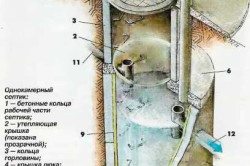
The scheme of waterproofing a single-chamber septic tank.
The whole process is carried out using special quality sealants such as silicone.
Silicone has a high level of density and is capable of closing all openings through which wastewater can escape. Waterproofing septic tanks with such a hermetic material is the best way out in a situation where protection is needed long years... It is used in a wide variety of industries, including the construction segment. Other insulating agents are used, but silicones are still the most popular.
How to waterproof a concrete septic tank?
Depending on the level of groundwater, it is necessary to carry out waterproofing work in one way or another. The main thing to consider is that wastewater should not seep into the ground, because it contains a lot of unfavorable microorganisms. They multiply rapidly and pollute the environment. If the groundwater is located low, then microbes can enter it through the cracks, and if it is high, then the infection occurs instantly. To make a complete and high-quality sealing of a reinforced concrete septic tank, it is necessary to install a special plastic cylinder.
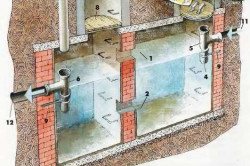
Diagram of a two-chamber septic tank.
It will need to be cut with a jigsaw at the desired height, and then inserted into the concrete rings. After that, you can carry out sealing in the area of \u200b\u200bthe seams with silicone. If the groundwater is high, it is necessary to reinforce the cylinder with special annular stiffeners. The concrete cylinder itself is a sealed device made of 8 mm thick polyethylene. The height of the plastic insert can be varied in the factory form from 1 to 4.5 m. The cylinder can be cut as needed to any level.
It is imperative to check the structure for functioning after winter, since due to the displacement of the soil (at first everything around freezes, and then it melts sharply, changing its consistency), problems with insulation may arise. Displacement of concrete rings in this case is quite possible, and therefore work on restoring the tightness of the sewer system must be carried out immediately. It is necessary that each ring fits snugly to the adjacent one, otherwise troubles cannot be avoided.
Another question to think about before carrying out is how far from the house the concrete structure will be. It is advisable to dig a hole away from the residential building, since the smell from the drains can penetrate into the room and constantly spoil your mood. The waterproofing of the septic tank prevents the penetration of an unpleasant odor under normal operating conditions of the structure, but even this cannot be saved when cleaning the system.
It is quite possible to carry out waterproofing with your own hands. To do this, we recommend that you first familiarize yourself with all the information, prepare materials and tools and get to work.
So, to build and waterproof concrete rings, you need the following tools and materials:
- a shovel to dig a well;
- cement (for the bottom of the structure);
- sand (to create a soft pillow);
- lifting crane (for immersion);
- several concrete rings;
- silicone as a sealant;
- jigsaw for cutting a cylinder;
- special plastic cylinder approximately 8 mm thick;
- metal staples for fastening.
What else do you need to know about a septic tank?
It is worth saying that in addition to concrete septic tanks, there are many others. But this particular type is popular because of its advantages, the main of which is ease of installation. The second plus that concrete has is that it is easy to insulate it and you can do it yourself. It is also very important that one septic tank with three wells may well meet the needs of an average family. The minimum amount of additional assistance (such as cranes) is required.
Waterproofing septic tanks is also a relatively simple process, but each step must be meticulous. It is very important that after winter, when the concrete absorbs all moisture (after freezing), the tightness of the structure does not break. This is the minus of a concrete septic tank - the ability to deform after absorbing moisture. There have been no other drawbacks over the years of using this type of septic tank.
It is necessary to monitor carefully, and at the first depressurization it is necessary to carry out additional work to isolate the concrete rings. All work can be carried out independently, as an option - you can entrust the construction and waterproofing of a septic tank made of concrete to professionals.
A common suburban method of collecting wastewater into a well system requires careful sealing of septic tanks made of concrete rings, which are the main component of the storage and treatment of sewage water. Leaky conjugation of the rings leads to filtration of fecal runoff into the soil and further into the underground horizons of groundwater, their contamination with pathogenic microflora. The reverse process also takes place - filling the septic tank wells with groundwater, which leads to their premature filling.
Structures created using reinforced concrete elements are often presented as structures that are not subject to temporary destruction. This opinion is only partially true. Reinforced concrete is a strong and durable material, but it requires protection. Sewer drains contain a huge set of aggressive components that negatively affect the material of the rings and can lead to the following:
- violation of the structure of the concrete mass due to leaching processes;
- development of corrosion processes in reinforcement belts;
- critical weakening of the bearing capacity;
- complete loss of structural qualities of reinforced concrete products.
The underground location of septic tanks naturally makes it difficult to carry out repair and restoration activities. Large volume earthworks, lifting rings to the surface for restoration or replacement requires the involvement of earthmoving and lifting equipment. This leads to high financial costs, violation of the landscape improvement of the site. The forced cessation of access to public amenities is a big inconvenience.
A septic tank made of concrete rings, which was waterproofed at the stage of its construction, can be effectively operated for many years, while requiring minimal maintenance. Competently executed waterproofing of a septic tank from concrete rings, in addition to protecting against premature destruction of the structure itself, will save you from other unpleasant phenomena. Signs of unsatisfactory tightness of the septic tank can be contamination of water in wells and wells with pathogens and the spread of odors of decomposing sewage throughout the site.
There is an opinion about the futility of carrying out measures to seal the ring joints. As a weighty argument, a composite structure of the well is given, the sealing of which can be easily destroyed by a seismic shock, seasonal heaving or other ground movements. Insinuations on this topic are untenable for several reasons:
- During the construction of wells, concrete rings can be reliably fixed against possible displacements with metal fastening elements.
- The industry produces well rings, in the design of which special locks are integrated, preventing the elements from displacing relative to each other.
- Known technological methods of waterproofing, which exclude the possibility of leakage, even if the ring receives some displacement relative to the other.
Violation of the technology for performing work on sealing the joints of the rings leads to the same consequences that arise in the complete absence of waterproofing.
 Various methods and types of sealing ring junctions are known and applied. Performing work according to some of the methods involves the use of equipment with specific properties. Other technological processes are available for quality execution only by specially trained specialists. There are also methods for arranging waterproofing that are available for doing it yourself. A reasonable choice in favor of one or another method of sealing can only be made by gaining an idea of \u200b\u200bthe technological features, advantages and disadvantages of each of them.
Various methods and types of sealing ring junctions are known and applied. Performing work according to some of the methods involves the use of equipment with specific properties. Other technological processes are available for quality execution only by specially trained specialists. There are also methods for arranging waterproofing that are available for doing it yourself. A reasonable choice in favor of one or another method of sealing can only be made by gaining an idea of \u200b\u200bthe technological features, advantages and disadvantages of each of them.
All differences between waterproofing methods lie in the field of materials used, methods of processing and budgetary load. Most widespread received 6 types of waterproofing.
Penetrating chemical compounds
Many security professionals reinforced concrete structures consider this type of concrete protection to be the best of all. Penetrating waterproofing is performed using compounds with specially developed physical and chemical properties. Chemical mixtures penetrate into the concrete mass of the structure, filling the pores and voids, followed by crystallization. This process has a prolonged effect: an increase in the humidity level initiates its slowdown, and a decrease, on the contrary, accelerates it. This allows waterproofing compounds to quickly fill cracks that appear in the concrete mass.
The significant disadvantages of penetrating waterproofing include its high cost and laboriousness of implementation. The concrete surfaces of the well rings require careful preparatory measures and preliminary processing.
Application of bituminous materials
Giving waterproofing properties to various structural materials by treating them with heated oil bitumen is one of the most used methods in the recent past. The advent of modern waterproofing materials has left this method with only one advantage - its low cost. Bituminous coatings have a low resistance to variable temperature changes. Low adhesive interaction with concrete surfaces provokes peeling and cracking of the waterproofing bitumen layer.
Another type of material that has a bituminous component as a base is specialized mastic. Its composition integrates additives with special properties, which are designed to increase the resistance of the waterproofing layer and significantly increase its service life. The advantage of using mastics over bitumen is also cold way their application to the insulated surface, which greatly simplifies and speeds up the work.
In order to improve the waterproofing properties and increase the service life of bituminous coatings, experts recommend complementing the wrapping with roll waterproofing. For this, roofing material can be used, but the best effect is the use of welded roll materials.
Polymer-cement mortars
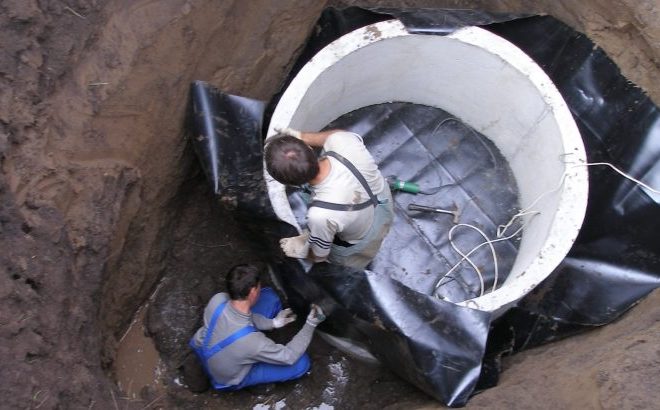 Hydraulic isolation of well rings in septic tanks can be performed using cement compositions with the addition of modifying polymer components. The cost of various polymer-cement compositions is higher than bituminous materials, but they have much less penetrating chemical mixtures. The solutions are applied in 2-3 coats with a regular brush - a wide flat brush. The application process does not take much time for the reason that the application of the second and subsequent layers is carried out without waiting for the previous one to dry.
Hydraulic isolation of well rings in septic tanks can be performed using cement compositions with the addition of modifying polymer components. The cost of various polymer-cement compositions is higher than bituminous materials, but they have much less penetrating chemical mixtures. The solutions are applied in 2-3 coats with a regular brush - a wide flat brush. The application process does not take much time for the reason that the application of the second and subsequent layers is carried out without waiting for the previous one to dry.
Clay waterproofing lock
The presence of sand-free clay layers at a short distance from the site allows for external waterproofing of septic tank wells with the arrangement of a clay castle. The space surrounding the installed and fixed rings is filled with clay and compacted by ramming each poured layer. Clay locks generally complement bitumen hydraulic insulation. For obvious reasons, this method cannot be used in the inner cavity of the well.
Hydraulic plaster insulation
The method consists in two-layer plastering of the inner or outer surface of the well using special equipment... Cement guns are used as it, with the help of which plaster mortar is applied to the walls of the rings under high pressure. The method is not widely used for several reasons. In addition to attracting specific equipment, the process takes a long time period.
Insulation with plastic shell
 Effective hydraulic isolation of wells from the inside can be performed by installing a sealed polymer insert into the cavity of a septic tank. The latter is a structure made of durable polymeric materials, the linear dimensions are selected corresponding to the cavity of the well. Additional rigidity of the structure is provided by the integration of reinforcing elements in the form of ribs into its surface. The access to the inner space of the insert is through a hatch provided by the design.
Effective hydraulic isolation of wells from the inside can be performed by installing a sealed polymer insert into the cavity of a septic tank. The latter is a structure made of durable polymeric materials, the linear dimensions are selected corresponding to the cavity of the well. Additional rigidity of the structure is provided by the integration of reinforcing elements in the form of ribs into its surface. The access to the inner space of the insert is through a hatch provided by the design.
The use of a polymer insert allows you to restore an old well from concrete rings that has lost the required performance. The space remaining between the insert and the inner surface after the installation is completed is filled with a cement-sand mortar.
Sealing ring seams
Without careful sealing of the ring mates, even the best hydraulic surface sealing will not provide full results. Seams between adjacent concrete rings are the most vulnerable spot of any well structure. It is in these places that the first filtration in both directions begins in case of violations in the orientation of the rings. To prevent leaks, proven methods are used:
- The ring joints are sealed with gaskets with bentonite granules integrated into the rubber mass.
- The annular joints are sealed with a rubber strip reinforced with a UV-curable sheet.
- The joint between the rings can be concreted with polymer-cement mortar. The role of a deformation compensator with this method is performed by an additionally laid rope made of natural materials.
The need to perform high-quality hydraulic isolation of the septic tank is beyond doubt. It seems important optimal choice types of insulation, thorough preparation and professional performance of work.
One of the prerequisites for achieving a comfortable stay in the country or in a country house is the presence of all plumbing fixtures and their normal functioning, which cannot be achieved without a good sewage system. The idea immediately comes to installing a septic tank made of reinforced concrete rings on the territory of your estate. It is not at all difficult to carry out such a construction at home. To do this, you need to dig a hole with an excavator or manually, and install reinforced concrete rings using a truck crane (or manually).
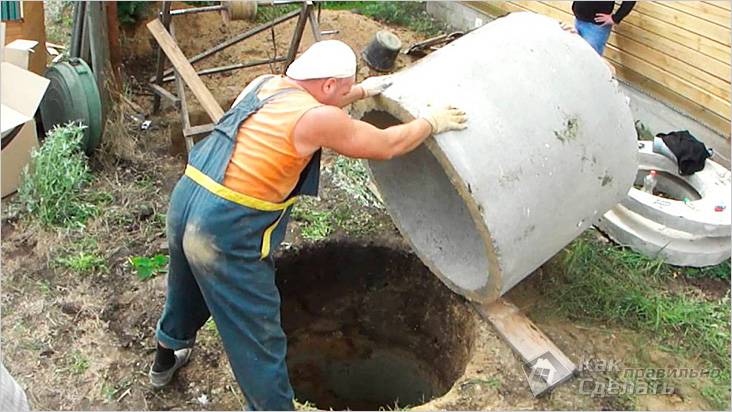
After completing the installation work, it is necessary to seal the septic tank for its correct operation. In this article, let's go over all the details of sealing work. Using these recommendations, it will not be difficult to do the work on your own.
Purpose of sealing

Currently, the use of a septic tank made of concrete rings is popular among owners of summer cottages and private houses. But it's no secret that for the septic tank to work properly, it is necessary to waterproof it - this will make it airtight. This work should be done without fail. If you neglect these rules, then a septic tank can become a source of infection in a personal plot. Sewage will seep through the leaking walls of the septic tank, thereby contaminating groundwater. And the ingress of the groundwater itself into the septic tank will overflow it and lead to malfunction. This is why sealing a concrete septic tank is so necessary and protects the entire concrete structure.
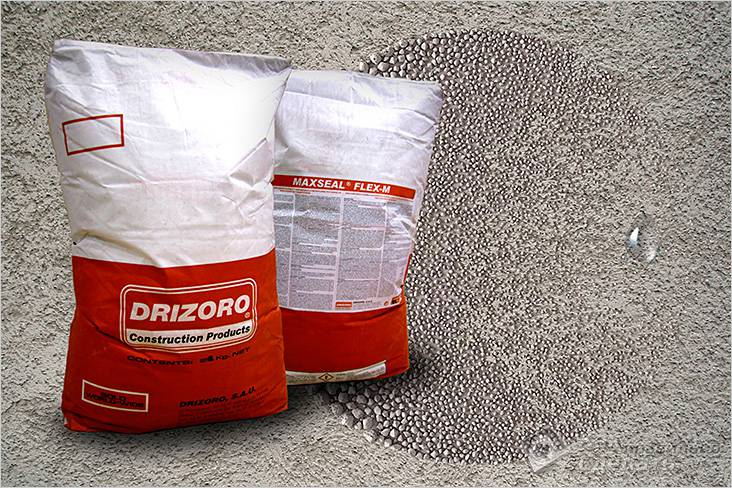
Mainly used for sealing:
- bituminous waterproofing;
- penetrating waterproofing;
- polymer-cement waterproofing;
- plastic inserts;
- silicone.
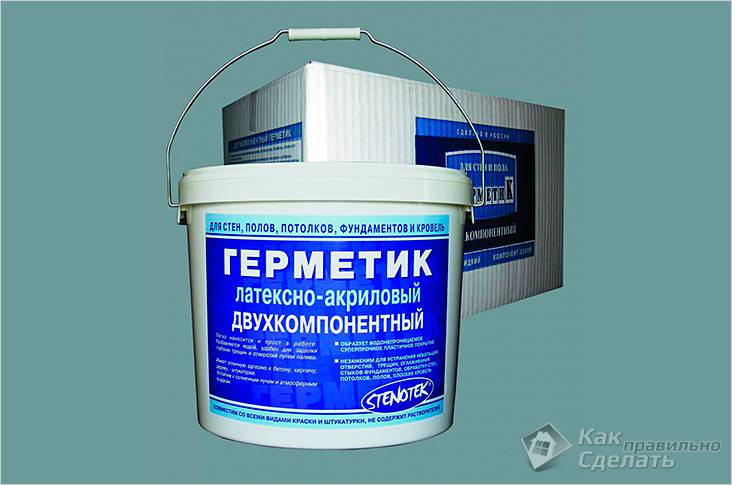
By its structure, silicone is characterized by a high degree of density. By processing the entire surface of the concrete rings, the silicone gets into all holes and crevices. Thus, preventing both the ingress of groundwater into the septic tank and the release of sewage into the ground. Of course, other means for sealing are used, but silicone has the highest degree of protection.
Sealing process

So, you installed concrete rings in the dug hole using a truck crane. If the edge of the ring has a special lock for mounting, then its connection will be tight. Rings with a flat edge do not have a good tightness, so the joints must be sealed with a sealant cement base.
The lower ring with the bottom of the pit should have a special tightness. When the ring design has a molded bottom, there is no question of additional sealing. But if you installed a simple ring, then the bottom of the pit must be concreted before installation. The bottom of the pit is concreted using reinforcement mesh... From pieces of reinforcement to the size of the bottom of the pit, a grid is laid out on a brick. The rods are tied together with wire and poured with concrete with the addition of crushed stone. After installing the ring on the homemade bottom, all the gaps formed between the bottom and the flat edge of the ring are well sealed. Sealing is also performed with a cement-based sealant. Further, the sealing is performed depending on the location of the groundwater. After all, this whole process is designed to prevent the contact of sewage with soil and water.
Sealing of a septic tank from concrete rings is carried out in two ways:
- With a low location of groundwater, reinforced sealing is performed on the bottom of the septic tank. This prevents germs from entering the soil and water through the crevices.
- With a high groundwater table, instant infection occurs due to contact with sewage. Therefore, reinforced sealing of the upper part of the septic tank is performed.
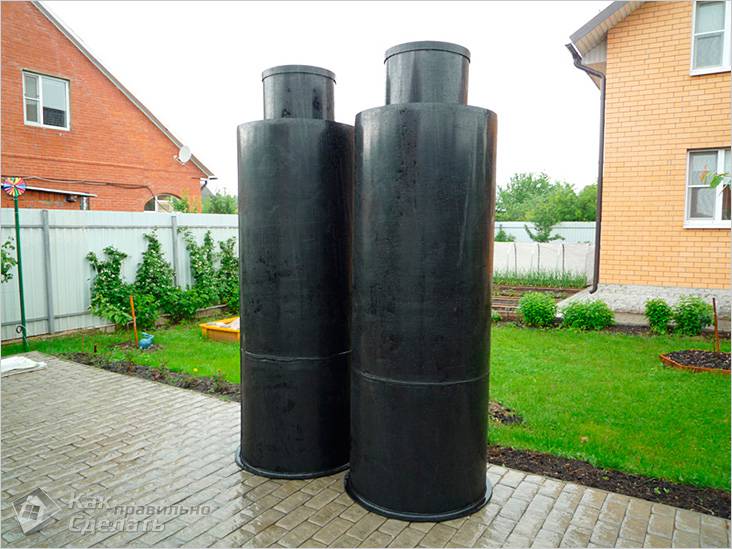
The best option is to completely seal the concrete septic tank. It is performed by installing plastic cylinders. The cylinder is made of polyethylene with a wall thickness of 8 mm. Its height can be from 1 to 4.5 meters. The material from which the cylinder is made has a high tightness. It is more profitable to install a one-piece cylinder to reduce the consumption of silicone for sealing joints.
The polyethylene cylinder is cut to size with a jigsaw and inserted into concrete rings. All joints and seams are filled with silicone for complete sealing. To prevent rain and melt water from flooding the septic tank, additional strengthening of the top of the cylinder is performed. To perform this work, annular stiffeners are used.
After completing all the sealing work, the pit with concrete rings is covered with earth and the septic tank is ready for work.
After the first winter, it is necessary to check the structure for leaks. Due to frost and thaw, the soil is displaced, and the concrete rings can move from their place, breaking the insulation of the septic tank. To avoid trouble, you must immediately begin to restore the septic tank and its tightness.
It is not difficult to isolate a septic tank from concrete rings and can be done by hand. To do this, you will need to familiarize yourself with the technology of the work being carried out, collect some information and purchase necessary materials... For a better introduction, you can watch the video at the end of the article. And if everything is clear, feel free to get to work.
Video
This video demonstrates how to eliminate water leakage between concrete rings:
This video shows how the Raberit waterproofing test was carried out on a concrete ring:
Good day! Tell me what is the best way to waterproof concrete rings? Do they need to be pre-dried? And is it possible to do it yourself?
Hello.
It is a pity that you did not specify for what type of structure concrete rings are used and what it is. The answer would be shorter and more accurate. Because, for example, different requirements are imposed on the insulation of a drinking water well and a septic tank with fecal waste. Since we do not know anything about your rings, we will have to limit ourselves to considering the basic principles of waterproofing underground structures from precast concrete elements.
Types of waterproofing materials
For waterproofing underground structures, we recommend using three types of materials: cement-polymer compositions, bitumen-polymer and polymer insulation:
- Cement-polymer mixtures
They are inexpensive, have excellent adhesion (ability to adhere to the surface) to concrete, and are very durable. Moreover, the reliability of penetrating cement waterproofing only grows over time, and the service life is at least 40 years. The application method is extremely simple: it is enough to apply the composition to the mineral surface with a brush or a spatula in two or three layers.
It is not difficult to apply cement-polymer waterproofing with your own hands, you do not need to have any special qualifications or special tools
There is no need to dry the concrete; on the contrary, you need to moisten it. Work can be carried out in almost any weather at temperatures above +5 ºС. Concrete products should be pre-prepared: cleaned of dirt, it is more convenient to do this with a high pressure washer. Wash sinks and irregularities with mortar or repair compound, you can use frost-resistant tile adhesive. Cement-polymer insulation has one more very useful property: without allowing water to pass through, it is capable of passing water vapor, which is important for serviced wells. Most of the cement-polymer mixtures are suitable for the treatment of drinking water tanks.
The choice of brands of cement-polymer compositions is quite wide. From domestic, we can recommend Penetron compositions (http://penetron.ru), from foreign - Ceresit products (http://www.ceresit.ru/products/waterproofing_materials), which are mostly produced in the Russian Federation, EurAsEC countries and Ukraine under strict control of German technologists.
It should be borne in mind that standard inexpensive cement-polymer compositions are very resistant to abrasion, but inelastic. If a crack occurs in a concrete structure (as a rule, this occurs at the joints between the rings), the integrity of the waterproofing coating will also be violated. If the structure is unstable, there is a risk of cracks, or they have already appeared, the problem can be solved using a special elastic tape for sealing joints (for example, CeresitCL 152) or a two-component compound with increased elasticity (CeresitCR 166), applying it in two layers with intermediate reinforcement fiberglass mesh. True, these materials can no longer be called cheap.

Elastic seam tapes are more often used to seal the joint between vertical and horizontal surfaces, but can be used for any problematic seams, cracks
- Bitumen-polymer waterproofing
We do not recommend using bituminous materials (roofing felt, mastics) without polymer additives, they are cheap, but their service life is only 5-15 years. Polymer-bitumen waterproofing can be coated (mastic) and welded (rolls glued to the mastic in a hot way. The latter is much more expensive than coating, more difficult to install, requires a special tool.
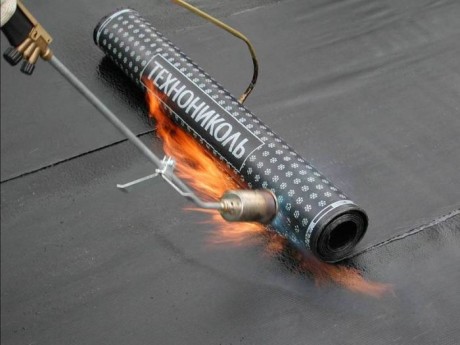
In order to qualitatively weld roll insulation, you need to have a special gas burner, a more accessible blowtorch will not give the desired result
However, deposited insulation is more reliable and more durable, its service life reaches 30 years. The roll material tends to stretch a little, small cracks in the concrete structure are not terrible for the waterproofing coating.
With excellent waterproofing properties bitumen-polymer materials have mediocre adhesion to concrete. Applied to a clean, leveled and dry surface, they will only hold securely until the moisture content of the concrete becomes too high. If the base is wet, capillary moisture will gradually begin to tear off the bitumen material from the mineral surface; if it gets wet, the insulation can completely come off. When rolled waterproofing is glued to concrete rings from the outside and pressed down with soil, it still has no place to go, even if it has moved away from the surface. But if it is applied from the inside of the well, and the concrete is often and abundantly moistened, over time it can move away in places and stop performing its functions, or even the rolls will completely peel off and fall to the bottom of the structure in a useless heap.
- Polymer insulation
It is similar in properties to bitumen, but significantly surpasses it in elasticity, which is why polymer roll membranes and mastics are recommended to be used for deforming surfaces in which unstable cracks may appear. The service life is also significant - 40 years.
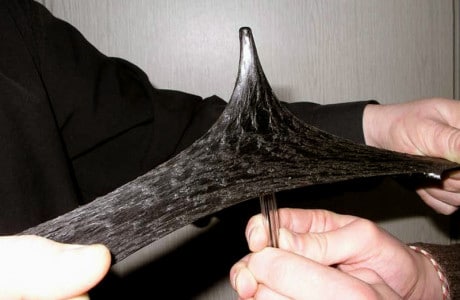
« Liquid rubber"(Polymer mastic) - the most elastic waterproofing material
Alas, the high price limits the use of polymer insulation.
A good price / quality ratio has a Russian-made bitumen-polymer and polymer waterproofing "Technonikol" (http://www.tn.ru/catalogue/?bokm_id\u003drullon_materials).
Pay particular attention to sealing the joints between the rings
Concrete compacted at the factory almost does not allow water to pass through, we can only talk about capillary penetration, if the products are of high quality. Practice shows that in wells assembled from standard concrete rings, leaks occur mainly due to leaks in the joints. It is important, even at the installation stage, to ensure that the joints between the rings are filled with mortar. Knead it on the basis of Portland cement and sown sand in a ratio of 1: 3. The result will be much better if Penetron Admix is \u200b\u200badded to the mixture, it will give the solution waterproofing properties.
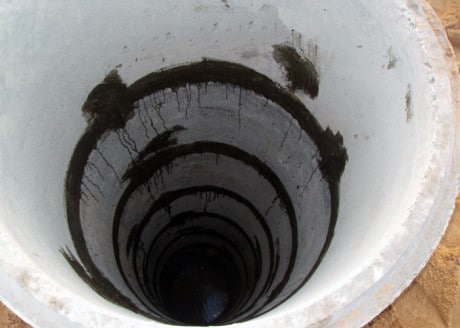
Careful sealing is a prerequisite for high-quality waterproofing
Drinking water well insulation
For waterproofing tanks with drinking water, only cement-polymer compounds should be used, on the packaging of which this is clearly indicated. Bituminous - it is impossible. Wells, as a rule, have a great depth and are built using the sequential lowering method reinforced concrete rings with parallel excavation. This technology gives two limitations: waterproofing can only be done from the inside, the assembly sealing of the joints between the rings often leaves much to be desired due to small displacements during the settlement process. If there is a concern about the quality of the joint, the mortar should be removed from the seam to a depth of 25-50 mm, fragile fragments that crumble and crumble when hit with a hammer should be removed completely. Thoroughly fill the joints with a special non-shrinking waterproofing cement-polymer mixture (for example, Penekrit).

When filling the seam to a great depth, you will have to do it not in one, but in two or three steps
If the well is located in very wet soils and an active leak needs to be eliminated (water washes away the usual mixture for joints), the leak can be sealed with a quick-setting cement-polymer hydraulic seal ("Peneplag"). Then treat the entire inner surface of the well with penetrating insulation (for example, "Penetron") and keep it wet for two weeks.
No matter how carefully you do the waterproofing of the well, do not neglect the cheap and effective methods drainage: arrange a blind area over a clay castle.
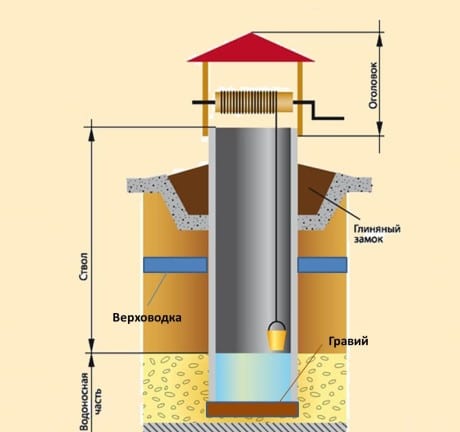
A castle made of oily clay will drain melt and rain water, prevent it from seeping along the walls of the well
Septic tank isolation
If we are talking about a multi-chamber septic tank for wastewater, it is not necessary to isolate the last absorption well in the chain. On the contrary, water should leave it in the ground in the maximum amount. And there is no special need for waterproofing the first sections of the septic tank that are not located below the groundwater level. Is that, this is required by nature conservation. It is not scary for the environment if a little runoff seeps into the ground, it is an excellent biofilter. What is really needed is to prevent large quantities of melt and rainwater from entering the structure. To do this, it is enough to carefully embed the seams between the rings, do not forget about the cover, the head of the well, the pipe entries.
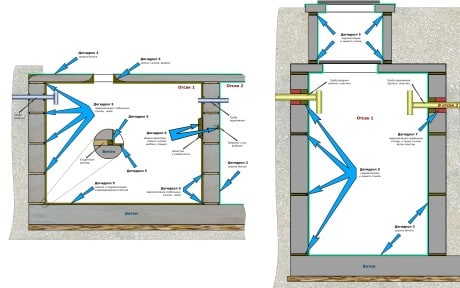
When waterproofing a septic tank, focus on sealing joints between prefabricated structural elements
If waterproofing is still done, the material is chosen depending on whether it is an external surface or an internal one. During the construction of a well by the method of sequential lowering, insulation is performed from the inside and only with the help of cement-polymer compounds, bituminous ones will not hold well. If the hole was dug by an excavator, there is enough space to waterproof the outside. In this case, any material can be used. It is convenient to melt the rolled bitumen-polymer coating on the ring even before installation, when it is located on the ground surface. And having installed in place, glue only the joint between the rings.

Bituminous insulation is only suitable for use outside the structure
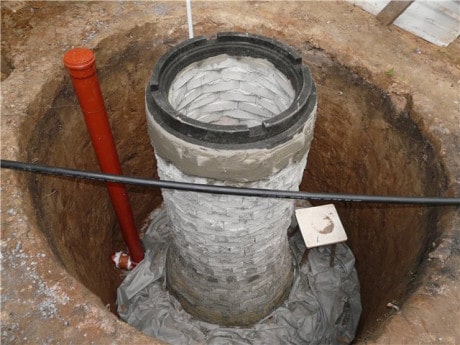
Do not stick the roll material on an uneven surface. The head of the septic tank, lined with concrete bricks, covered with a polymer-cement composition
Insulation of the process well
For a dry well located in wet ground, waterproofing is required. The application technology is the same as for a septic tank. If possible, it is better to isolate the structure from the outside. Not only the walls should be protected from moisture, but also the bottom of the well. For external insulation, a bitumen-polymer or cement-polymer coating should be applied to the concrete bottom slab prior to mounting the rings. You should also pay attention to the height of the hatch relative to the ground: during rain, water should not flood it.

If possible, waterproofing can be performed on both sides, this will increase reliability. In the photo - a serviced technological well for the input of communications, the outer and inner surfaces are treated with an inexpensive cement-polymer composition
In any water supply and drainage system, it is extremely important to ensure a competent waterproofing of the structure, so that leaks and the ingress of groundwater into the reservoirs are eliminated. This issue is also relevant when protecting special structures - wells made on the basis of concrete rings, since they are often used as containers for drinking water, or as an autonomous sewage system.
Wells built using prefabricated components are advisable to be erected to make a storage tank for technical, drinking water or organize a sewage system. The given first two options are especially demanding to prevent leakage of underground sources inside, since this can adversely affect the quality of water.
Note that improper design and processing of such a system can lead to deterioration of the condition of the soil and groundwater where the corresponding reservoir is located. For this reason, waterproofing of sewer wells, made on the basis of concrete rings, is carried out already at the stage of construction.
Septic tanks
Sewerage wells need a mandatory waterproofing device that provides reliable protection environment from the ingress of sewage into it. Note that they can have not only a huge amount of organic substances, but also many disease-causing organisms. Of course, contaminated soil can adversely affect plants and human health.
Drinking wells
Drinking wells seek to isolate from the penetration of ground surface water into them. This is explained by the fact that they contain all kinds of bacteria and large suspended matter. The ingress of even a small part of such a solution into the reservoir can cause significant damage to the human body.

Figure # 1. Waterproofing joints
When to update waterproofing
Concrete rings from the outside and from the inside are usually processed even at the initial stage of the construction of the well, since the material from which they are made easily absorbs moisture. During the operation of the structure, it may be necessary to restore the protective coating, indirect signs of which may be the following factors:
- - the appearance of displacement of the rings relative to each other;
- - too fast and excessive filling of the sewer system;
- - mechanical and chemical destruction of the components of the well, with the formation of cracks, which will inevitably cause leakage of the contents;
- - determination of centers of corrosion of reinforcing elements, which leads to seepage of ground moisture through the waterproofing of the septic tank.
In each case, it is necessary to immediately restore the protective coating and seal the seams. Lack of attention can lead to the appearance of an unpleasant smell, in the case of sewage, or deterioration of the quality of drinking water in the corresponding wells.
Reliable construction of concrete elements, taking into account the effect of aggressive media and substances on them, is feasible only with waterproofing of a septic tank.
Video # 1. Well waterproofing
Protection with plaster
Often, in the construction of tanks, finishing is used outside and inside by means of a special component, cement, which has a low% shrinkage and water permeability. It is applied to the surface using compressed air, under significant pressure. The result is a compacted and even layer over the entire working area of \u200b\u200bthe structure.
Processing is carried out using a "cement gun". It is recommended to lay the mortar in two layers, while the thickness of each should be within the range of 5..10 mm, with a minimum air temperature of at least +5 degrees. The next layers are applied when the previous one is completely dry, which may take a total of about 10 days.
Due to the high evaporation, in hot weather, the applied coating must be watered after 4..5 hours. In moderate conditions, the specified interval can be increased by 2-3 times.
Bituminous waterproofing
The simplest and most reliable method of sealing is considered to be the use of hot bitumen. The material is an excellent insulator, but it does not tolerate temperature changes and is prone to delamination over time. In view of this, mastics and additional components are added to the bitumen mixture.
Before starting work, you will need to thoroughly clean the outer and inner parts of each ring. Then the first bitumen layer is applied, prepared using gasoline in a ratio of 1 to 3. Further application of the material is provided with a solution in a ratio of 1 to 1. It is advisable to keep all layers until final drying. Each subsequent layer based on hot bitumen is spread with a roller or brush.

Figure # 2. Bituminous waterproofing of concrete rings
Mastic is laid on top of the hardened bitumen in a layer within 2..3mm. On the outside of the concrete rings, on top of the mastic, roofing material or any other insulating element is fixed.
The advantage of bituminous waterproofing of a septic tank is the ease of implementation of work and their relative availability. At the same time, it is impossible to obtain a 100% guarantee of protection here; moreover, the method is not recommended for drinking tanks.
Penetrating protection
Penetrating waterproofing has proven itself to be a fairly reliable, proven and effective way to protect concrete rings. Excellent parameters are shown by innovative and progressive formulations, including Penetron, Lakhta, Hydro S and others, which are capable of maintaining their characteristics throughout the entire period of operation of the wells.
Each of these components is able to easily penetrate into the pores of concrete, fill all cavities and crystallize in them. The resulting structure retains its breathable base while acquiring unique waterproofing properties. As a result of processing the base of each ring, outside and inside, a surface with a uniform and tight composition is provided. This allows it to withstand high pressure and head of aggressive media for a long time.
Depending on the temperature conditions, humidity, porosity and density of the material, the crystallization time of the composition, as well as the depth of its penetration, may differ. Note that the increase in moisture affects the acceleration of the process of creating crystals. This material behavior allows concrete rings to impart a special "self-healing" property.
It should be understood that the penetrating waterproofing of the septic tank is performed exclusively on a properly prepared surface. For this purpose, concrete is ground mechanically or chemically until a homogeneous rough surface appears.
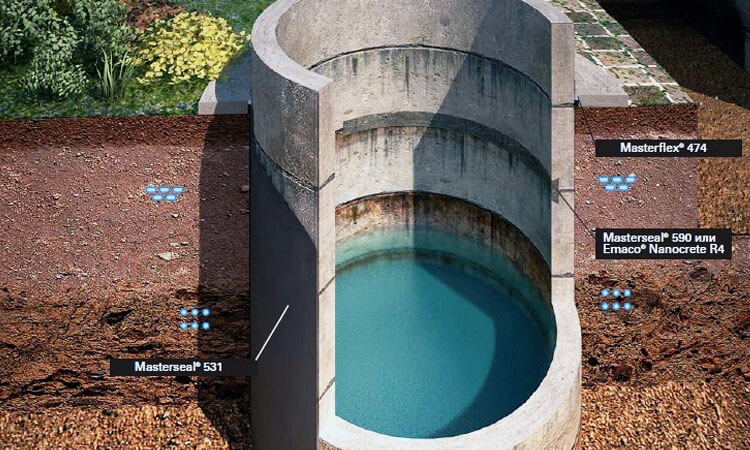
Figure №3. Well waterproofing
Polymer-cement protection
The most advantageous in terms of availability and easy to apply is polymer-cement or coating waterproofing... It is carried out by distributing a special mixture based on cement, water glass and polymers. The specified protection has the same effectiveness as bituminous, while being able to last a much longer period.
Conclusion
As you can see, it is not easy to waterproof septic tanks and wells based on concrete rings, however, it is impossible to do without it. It is important to be responsible and attentive to this issue. In the absence of the necessary skills and knowledge on the choice of waterproofing, it is advisable to entrust this matter to professionals.



